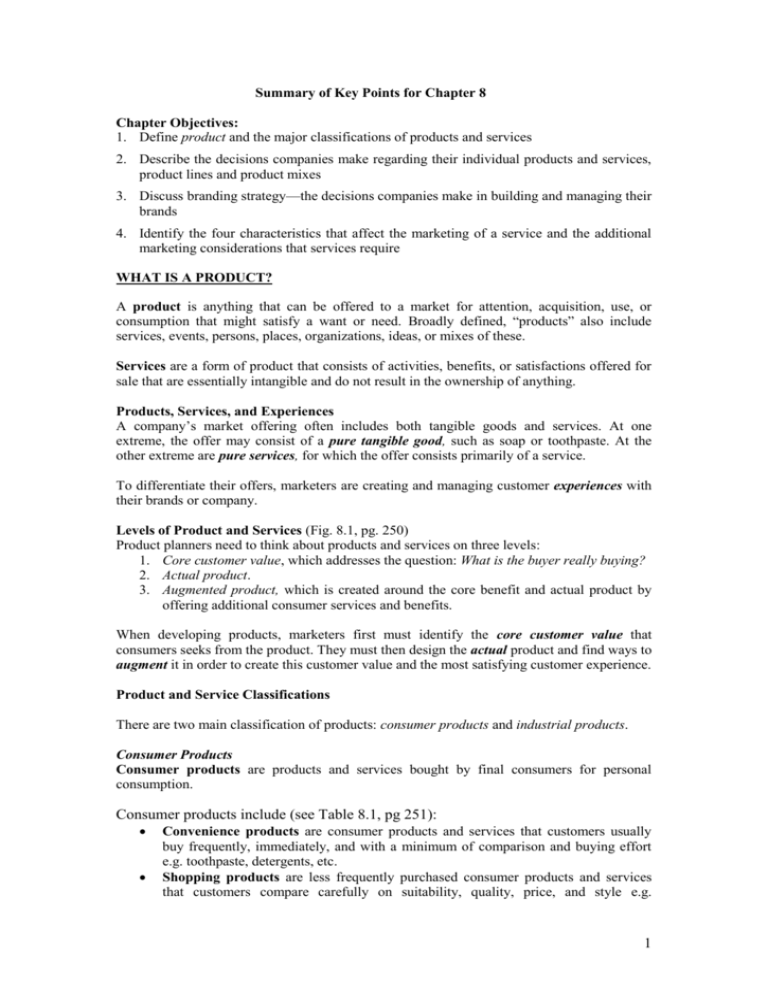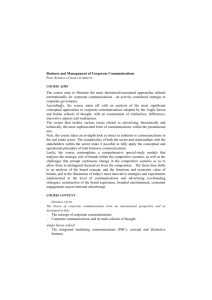Summary of Key Points for Chapter 5
advertisement

Summary of Key Points for Chapter 8 Chapter Objectives: 1. Define product and the major classifications of products and services 2. Describe the decisions companies make regarding their individual products and services, product lines and product mixes 3. Discuss branding strategy—the decisions companies make in building and managing their brands 4. Identify the four characteristics that affect the marketing of a service and the additional marketing considerations that services require WHAT IS A PRODUCT? A product is anything that can be offered to a market for attention, acquisition, use, or consumption that might satisfy a want or need. Broadly defined, “products” also include services, events, persons, places, organizations, ideas, or mixes of these. Services are a form of product that consists of activities, benefits, or satisfactions offered for sale that are essentially intangible and do not result in the ownership of anything. Products, Services, and Experiences A company’s market offering often includes both tangible goods and services. At one extreme, the offer may consist of a pure tangible good, such as soap or toothpaste. At the other extreme are pure services, for which the offer consists primarily of a service. To differentiate their offers, marketers are creating and managing customer experiences with their brands or company. Levels of Product and Services (Fig. 8.1, pg. 250) Product planners need to think about products and services on three levels: 1. Core customer value, which addresses the question: What is the buyer really buying? 2. Actual product. 3. Augmented product, which is created around the core benefit and actual product by offering additional consumer services and benefits. When developing products, marketers first must identify the core customer value that consumers seeks from the product. They must then design the actual product and find ways to augment it in order to create this customer value and the most satisfying customer experience. Product and Service Classifications There are two main classification of products: consumer products and industrial products. Consumer Products Consumer products are products and services bought by final consumers for personal consumption. Consumer products include (see Table 8.1, pg 251): Convenience products are consumer products and services that customers usually buy frequently, immediately, and with a minimum of comparison and buying effort e.g. toothpaste, detergents, etc. Shopping products are less frequently purchased consumer products and services that customers compare carefully on suitability, quality, price, and style e.g. 1 appliances, furniture, clothing etc. Specialty products are consumer products and services with unique characteristics or brand identification for which a significant group of buyers is willing to make a special purchase effort e.g. luxury goods. Unsought products are consumer products that the consumer either does not know about or knows about but does not normally think of buying e.g. life insurance. Industrial Products Industrial products are those purchased for further processing or for use in conducting a business. The three groups of industrial products and services are: Materials and parts include raw materials and manufactured materials and parts. Capital items are industrial products that aid in the buyer’s production or operations, including installations and accessory equipment. Supplies and services – supplies include operating supplies (paper, pens, etc) and maintenance and repair items (ladders, paint, etc). Business services include window cleaning, PC repair) and advisory services (e.g. legal, advertising). PRODUCT AND SERVICE DECISIONS (pg. 253) Individual Product and Service Decisions Product and Service Attributes Developing a product or service involves defining the benefits that it will offer. These benefits are communicated and delivered by product attributes such as quality, features, and style and design. a.Product Quality is creating customer value and satisfaction. Total quality management (TQM) is an approach in which all the company’s people are involved in constantly improving the quality of products, services, and business processes. Product quality has two dimensions: level and consistency. The quality level means performance quality or the ability of a product to perform its functions. Quality conformance means quality consistency, freedom from defects, and consistency in delivering a targeted level of performance. b.Product Features are a competitive tool for differentiating the company’s product from competitors’ products. The company should periodically survey buyers who have used the product and ask these questions: How do you like the product? Which specific features of the product do you like most? Which features could we add to improve the product? c. Product Style and Design is another way to add customer value. Style describes the appearance of a product. Design contributes to a product’s usefulness as well as to its looks e.g. OXO (pg. 254). Branding A brand is a name, term, sign, symbol, or design, or a combination of these, that identifies the maker or seller of a product or service. Branding can add value to a product. Building and managing brands is one of the most important tasks for a marketer. 2 Branding helps buyers in many ways. Brand names help consumers identify products that might benefit them. Brands say something about product quality and consistency. Branding gives the seller several advantages. The brand name becomes the basis on which a whole story can be built about a product. The brand name and trademark provide legal protection for unique product features. The brand name helps the seller to segment markets. Packaging: Packaging involves designing and producing the container or wrapper for a product. It can create immediate consumer recognition of a brand. Innovative packaging can be an advantage over competitors e.g. Heinz (pg. 256). Environmental concerns should also be taken into account when designing packaging. Labeling Labels perform several functions. The label identifies the product or brand. The label describes several things about the product. The label promotes the brand. Labeling also raises concerns e.g. it can mislead customers. As a result, several federal and state laws regulate labeling. Among details that should be included on a label: unit pricing (stating the price per unit of standard measure), open dating (stating the expected shelf life of the product), and nutritional labeling (stating the nutritional values in the product). Product Support Services The first step is to survey customers periodically to assess the value of current services and to obtain ideas for new ones e.g. Cadillac holds regular focus group interviews with owners. Next, the company can take steps to fix problems and add new services that will both delight customers and yield profits to the company. Product Line Decisions A product line is a group of products that are closely related because they function in a similar manner, are sold to the same customer groups, are marketed through the same types of outlets, or fall within given price ranges. Product line length is the number of items in the product line e.g. BMW has 3-series, 5-series and 7-series models and tries to encourage customers to move up this line. Product line stretching occurs when a company lengthens its product line beyond its current range. A company can stretch its line downward, upward or both ways: Companies located at the upper end of the market can stretch their lines downward e.g. Honda with Honda Fit (pg. 258). Companies located at the lower end of the market can stretch their product lines upward e.g. 3 leading Japanese car companies introduced upmarket cars using new brand names (pg. 258). . Companies located in the middle range of the market can stretch their lines in both directions e.g. Marriott Hotels (pg. 258). Product Mix Decisions Product mix (or product portfolio) consists of all the product lines and items that a particular seller offers for sale. BRANDING STRATEGY: BUILDING STRONG BRANDS Some analysts see brands as the major enduring asset of a company e.g. Napster, McDonald’s. Brand Equity is the positive differential effect that knowing the brand name has on customer response (preference, loyalty) to the product or service. A powerful brand has high brand equity e.g. Nike, Coca-Cola, Google, Apple, etc and, it is a very valuable asset. High brand equity provides a company with many competitive advantages. High level of consumer brand awareness and loyalty. More leverage in bargaining with resellers. More easily launch line and brand extensions. Defense against fierce price competition. Forms the basis for building strong and profitable customer relationships. Brand valuation is the process of estimating the total financial value of a brand e.g. Google’s is $86bn and Coca-Cola’s is $58bn. NOTE: Read Real Marketing 8.1 about the Top Ten Breakaway Brands (2008) - (pg. 261262) Building Strong Brands (Fig 8.3, pg. 262) Brand Positioning Marketers can position brands at any of three levels: 1. They can position the brand on product attributes. 2. They can position the brand with a desirable benefit. 3. They can position the brand on beliefs and values. Brand Name Selection Desirable qualities for a brand name include the following: (1) It should suggest something about the product’s benefits and qualities. (2) It should be easy to pronounce, recognize, and remember. (3) The brand name should be distinctive. (4) It should be extendable. (5) The name should translate easily into foreign languages. (6) It should be capable of registration and legal protection. 4 Brand Sponsorship A manufacturer has four sponsorship options. (1) The product may be launched as a manufacturer’s brand (or national brand). (2) The manufacturer may sell to resellers who give it a private brand (also called a store brand or distributor brand). (3) The manufacturer can market licensed brands. (4) Two companies can join forces and cobrand a product National Brands Versus Store Brands. National brands (or manufacturers’ brands) have long dominated the retail scene. In recent times, an increasing number of retailers and wholesalers have created their own store brands (or private brands). In the battle of the brands between national and private brands, retailers have many advantages. Retailers often price their store brands lower than comparable national brands. Store brands yield higher profit margins for the reseller. Store brands give resellers exclusive products that cannot be bought from competitors. Cobranding occurs when two established brand names of different companies are used on the same product e.g. Nike and Apple with Nike + iPod Sport Kit; Sony and Ericsson; etc. Cobranding offers many advantages. The combined brands create broader consumer appeal and greater brand equity. Cobranding also allows a company to expand its existing brand into a category it might otherwise have difficulty entering alone. Cobranding also has limitations. Such relationships involve complex legal contracts and licenses. Cobranding partners must carefully coordinate their advertising, sales promotion, and other marketing efforts. Each partner must trust the other will take good care of its brand. Brand Development A company has four choices when it comes to developing brands (see Figure 8.4, pg. 266): (1) Line Extensions occur when a company extends existing brand names to new forms, colors, sizes, ingredients, or flavors of an existing product category. (2) Brand Extensions extend a current brand name to new or modified products in a new category. (3) Multibranding introduces additional brands in the same category. (4) New Brands Megabrand strategy— weeding out weaker brands and focusing marketing dollars only on brands that can achieve the number-one or number-two market share positions in their categories. Managing Brands The brand experience is customers coming to know a brand through a wide range of contacts and touchpoints. Companies need to periodically audit their brands’ strengths and weaknesses. NOTE: Read Real Marketing 8.2 on Service Marketing (pg. 274-275). 5 SERVICES MARKETING Nature and Characteristics of a Service A company must consider four service characteristics when designing marketing programs: intangibility, inseparability, variability, and perishability (see Figure 8.5, pg. 269). (1) Service intangibility means that services cannot be seen, tasted, felt, heard, or smelled before they are bought e.g. getting a face-lift-can’t see the results before the purchase. (2) Service inseparability means that services cannot be separated from their providers, whether the providers are people or machines. Because the customer is also present as the service is produced, provider-customer interaction is a special feature of services marketing e.g. a lawyer has to be present to provide his service to the customer . (3) Service variability means that the quality of services depends on who provides them as well as when, where, and how they are provided to increase quality control, service orgs can invest in good hiring and training procedures, monitor customer satisfaction etc (4) Service perishability means that services cannot be stored for later sale or use e.g. when demand fluctuates, use PT employees, reservation systems (online check-in), differential pricing e.g. cheaper car rental rates on w/ends, automatic express checkout, etc Marketing Strategies for Service Firms The Service-Profit Chain In a service business, the customer and front-line service employee interact to create the service. Successful service companies focus on both their customers and their employees. The service-profit chain consists of five links: Internal service quality: superior employee selection and training, a quality work environment, and strong support for those dealing with customers, which results in... Satisfied and productive service employees: more satisfied, loyal, and hardworking employees, which results in... Greater service value: more effective and efficient customer value creation and service delivery, which results in... Satisfied and loyal customers: satisfied customers who remain loyal, repeat purchase, and refer other customers, which results in... Healthy service profits and growth: superior service firm performance. Service marketing requires more than the traditional external marketing using the 4Ps. It also requires internal marketing and interactive marketing. (Figure 8.6, pg. 271) Internal marketing means that the service firm must orient and motivate its customercontact employees and supporting service people to work as a team to provide customer satisfaction. Must train and motivate employees to serve customers well e.g. SIA’s TCS initiative- 40-30-30 rule (40% of resources go to training & invigorating staff, 30% on reviewing process & procedures, the last 30% on creating new product and service ideas). Interactive marketing means that service quality depends heavily on the quality of the buyer-seller interaction during the service encounter i.e. employees’ skill in serving the client. 6 Service companies face three major marketing tasks: They want to increase their service differentiation, service quality, and service productivity. Managing Service Differentiation Service companies can differentiate their service delivery by having more able and reliable customer-contact people, by developing a superior physical environment in which the service product is delivered, or by designing a superior delivery process. Service companies can work on differentiating their images (company credibility, perceived expertise, trustworthiness & likability) through symbols and branding (classes of service can be branded based on price & quality e.g. Hilton Hotels includes Hilton Garden Inns for budget-conscious business travelers). Managing Service Quality Service quality is harder to define and judge than product quality. Service quality will always vary, depending on the interactions between employees and customers. E.g. there must be a willingness to help customers & to provide prompt service with the provision of caring, individualized attention to customers. There must be the ability to perform the promised service dependably and accurately. Good service recovery can turn angry customers into loyal ones e.g. by responding quickly and personally to complaints and by developing a problem resolution system. Managing Service Productivity Service firms are under great pressure to increase service productivity. They can train current employees better or hire new ones who will work harder or more skillfully. They can increase the quantity of their service by giving up some quality. They can harness the power of technology. End-of-Week Questions: 1. Visit http://www.rim.com/, the home of Blackberry. What are consumers really buying? (note: look at the different levels of products). 2. Discuss the brand development strategies marketers use to develop brands. Provide an example of each strategy. 3. Restaurants have many of the fundamental service characteristics discussed in this chapter. Everyone is familiar with fast food and McDonald’s. Visit a local McDonald’s (or other fast food place) and discuss the basic characteristics of service you experienced. 7







